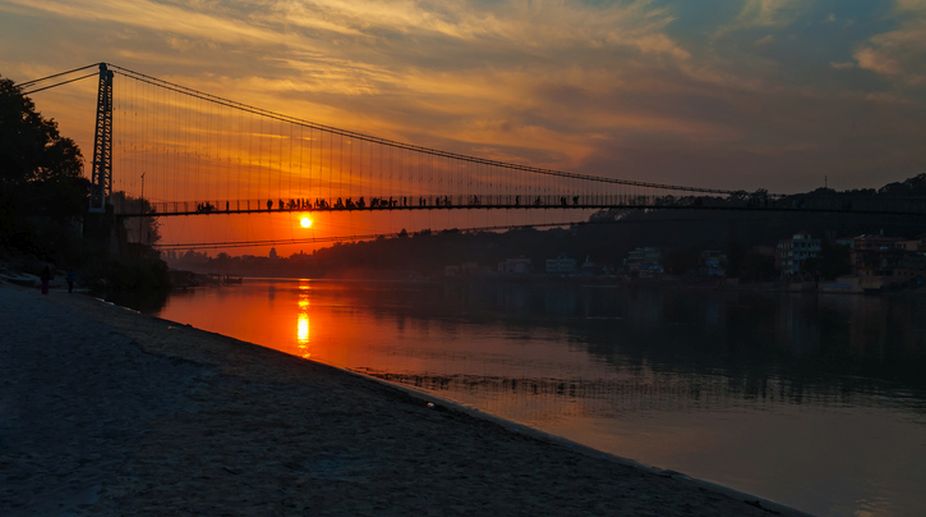When one thinks about Rishikesh, the images that immediately come to mind are those of tranquility in the foothills of the Himalayas, its holiness and the religious significance of the place.
Situated approximately 230 km from the Capital, this pilgrimage town is regarded as one of the holiest places for Hindus. The place is also popular as the Yoga Capital of the world.
Advertisement
However, in recent times there has been a change in the way we look at this place. What was once solely a pilgrimage town has now transformed into an adventure hub.
People from across the globe, throng this place to experience the fun filled thrilling activities that the place offers. Even in general, in India, there is a surge in interest for adventure sports. People across all age groups are taking to every kind of adventure activities.
Attracting tourists from all over the world, Rishikesh offers exciting activities such as white water rafting, cliff jumping, bungy jumping and flying fox to name just a few. White water rafting has always been a popular activity in Rishikesh, but now adventure enthusiasts have a choice of fun-filled and adrenalin coursing activities.
Speaking about this transition from a purely religious town to an adventure hub, Rahul Nigam, founder and managing director of adventure sports outfit Jumpin Heights, said, "It (Rishikesh) continues to remain a religious town and will always be one. It has developed into an adventure hub and is also known as an adventure Capital of India as more and more things have come up now. Even Uttrakhand government is taking lot of initiatives. We are both (religious and sports) simultaneously growing very well."
Development of Rishikesh
Col Manoj Kumar, co-founder of Jumpin Heights explained, "There was nothing here when we came in 2006. Over the period lot of camps have come up and the area is now very well developed."
White water rafting in Rishikesh began at a very small level in 1980's and subsequently grew by the 2000s. The turnover from camping and rafting business in Rishikesh is around Rs 60 crore annually.
"Youngsters should come and try these adventure sports. These are not just for thrilling experiences but are also the biggest confidence-building exercises. I have people come to me and tell me that these sports not only help in overcoming fear but also one gets a feeling that they can take on the world," added the ex-Army officer.
Must try things
The most important things to try in Rishikesh are Bungy jumping, white water rafting and staying in camps as it is an experience in itself. Some of the camps also offer trekking programs and biking tours. Apart from that, one should also not miss the sunset Ganga Aarti at Parmarth Niketan in Rishikesh.
The aura of the place would for sure fill a visitor with solace. Also, nonvegetarian food and alcohol is strictly prohibited in the place due to its spiritual importance.
Best season to visit
Although the place remains fully packed during the summer, the best time to visit Rishikesh for rafting, camping and bungy jumping is October to December.
The months of May and June remain quite hot with temperature crossing 35 degree Celsius. Almost 50 per cent of the crowd comes from Delhi. Most of the adventure sports cost around Rs 3,500 per person, which is fairly reasonable for an average citizen.
Pros and cons
Any adventure sport has a risk factor attached to it. Keeping this in mind, organisers have put in place several safety features, which is constantly updated. Yet there are accidents and unfortunate incidents, several organisers said. For instance, rafting in Rishikesh, although extremely popular, comes with a certain degree of risk.
There have been many incidents of casualties due to the overturning of the raft. This was primarily because of the illegal rafters outnumbering legal ones and flouting the rules. However, it's better to be safe than sorry. Therefore, it is advised to consider the danger aspect seriously and go in for the well-known rafting companies, who ensure emergency measures and thoroughly brief the participants to minimize risk.
In Bungy jumping, explained Nigam, there are only minor incidents like shoulder dislocation and the cord rubbing against one's cheek during the jump. He said, "Once a gentleman had a shoulder dislocation but in that case, it was his fault as he didn't inform us prior to the jump about his medical condition. However, we were able to correct it immediately."
He added, "If people inform us in advance about their medical condition, if any, then we strap them accordingly. We have a doctor on call 24×7." People with heart ailment, epilepsy, neck and back injuries are strictly prohibited in this sport. Riverside camps Camping on the banks of River Ganga is truly an incredible experience. One gets as close to nature as one can.
Housed completely in tents, with no electricity or running water, the facilities are absolutely basic. Even the washrooms are in tents and the icy-cold water dissuades even the most fetish people from taking a bath.
Trekking and white-water rafting are the main activities offered by these camps. However, with their rising popularity, there was a rampant proliferation of these rafting camps.
A petition by an NGO had in April 2015 sought the closure of these camps on the grounds that they contributed to the pollution of the Ganga. Apart from the lack of sewage or sanitation facilities, camp owners often left garbage, including plastic, leftover food as well as alcohol bottles and cans. This also impacted the wildlife habitat, the petitioner alleged.
The petition was also against Uttarakhand government's decision to issue licenses to a number of camping sites without considering the carrying capacity of the river Ganga. National Green Tribunal (NGT) had in July 2015 refused permission to rafting camps on the river banks from Shivpuri to Rishikesh. Now NGT has allowed beach camping in 25 out of 30 sites along the river Ganga in Rishikesh. As per its order, camping will be permissible outside a 100-metre radius from the middle of the river.
Environmental concerns
Environmentalists and local inhabitants are of the view that adventure activities and tourism should cautiously take into consideration environmental concerns also.
Environment activist and founder of Social Action for Forest and Environment (SAFE), Vikrant Tongad said, “In 2015 we had filed a petition in NGT against the “unregulated” operation of rafting camps in Rishikesh. The petition expressed concerns over “flattening of land” and “pollution caused by the temporary campsites” because of “improper sewage disposal, lack of sanitation and a general pollution caused by drinking alcohol, firecrackers, bonfire.”
He added, “Adventure sports are very important in terms of both being close to nature and revenue generation. However, one should also ensure that environment is not harmed and keep in mind all the dos and don’ts. Even locals opined that wrappers, empty alcohol bottles, leftovers of non-veg food remain near these campsites.”
Out of the 25 beach camp sites that are allowed by NGT only three the suitable for putting up camps and the rest are still partially within 100-metre radius from the river, said Tongad.











